By Gouri Satya, Sr.Journalist
Though authorities claim Mysuru as a ‘Heritage City’, the erstwhile royal city is facing the threat of losing its edifices fast and soon. Many heritage structures stand neglected with no up-keep, projecting their dismal condition. The latest addition to the list of such neglected structures is the Maharaja’s College Union Building, which is on the threshold of its centenary.
Weeds have grown almost all along the edges of the ceiling and a glaring fault line runs down towards the arch where the wooden protection has a crudely opened hole to take a cable into the building. The walls are shabby and plaster on them has peeled off at many places. Windows are broken and the roof is leaky, posing threat to the architecturally unique structure on the campus.
A prominently positioned sign board at the left corner of the aesthetic building says it is the “Union Building” and notifies both in Kannada and English, “Mysore Heritage”, indicating that it is a heritage building. It is built with brick and lime mortar, like many other heritage structures in Mysuru. I was told many students of architecture visit the heritage structure to study its unique architectural features.
Just a few months for century
The College Union was founded in 1915 while the Union Building came up in 1920. While the century-old Union no longer in existence, the Union Building is short of a few months of its century. The University should have thought of celebrating the occasion, taking pride in having such a beautiful two-storeyed building on the campus.
The Union Building was a hub of student and teacher activities right from its inception almost till about the 70s. It now houses the Department of Journalism, the Electronics Digital Information Centre, the Mysore University Employees’ Credit Co-operative Society, and ironically, the Department of Ancient History and Archaeology.
A similar building was built at the Central College Campus in Bengaluru, ten years later by Maharaja Krishnaraja Wadiyar IV.
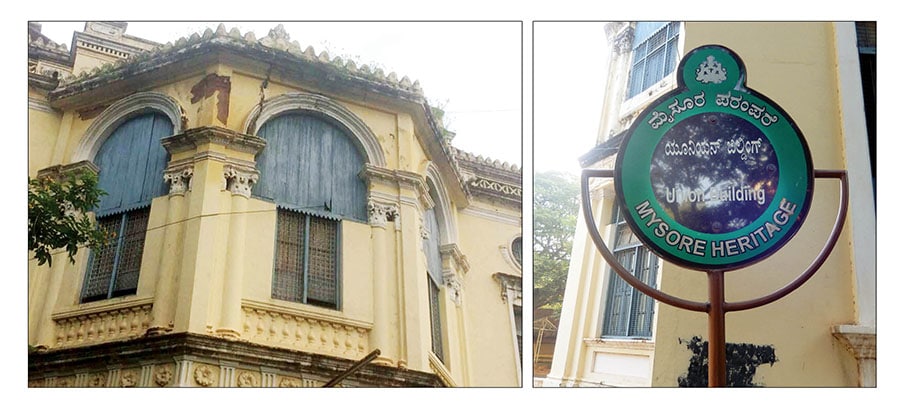
Desperate need for restoration
Sadly, a centre of activities and participation of such eminent teachers and students, who earned fame in the later years and earned laurels for the Maharaja’s College and the Mysore University, the Union Building today stands crying — crying for restoration. The Lansdowne Building and the Devaraja Market in the heart of the city have remained neglected for the last few years, obviously to allow them to collapse on their own, the civic body turning a deaf ear to the repeated plea from the public to restore them.
Just a few days ago, the portico of the century-old Fire Station at Saraswathipuram collapsed following heavy rains and now a proposal has been made to demolish its office building. Likewise, many other heritage structures that add grace and beauty stand neglected with no upkeep whatsoever. One only hopes that Union Building will not go the way these buildings are allowed to face damage, more so when its centenary is round the corner.
A hub of intellectual and cultural activity
Writing about the Union Building in Central College campus, Meera Iyer, Convener, Indian National Trust for Art and Cultural Heritage-Bangalore and a researcher, says, “Modelled after the Cambridge and Oxford Unions, among the two oldest debating and literary societies in the world, Central College’s Union had a reading room and library, facilities for table tennis, draughts and chess and most importantly, a debating hall. Unlike in the British University Unions, membership here was compulsory for all students of Central College and the Engineering College. The faculty was also members.”
“The College Union soon became a focus for intellectual and cultural activity. It hosted debates and talks by several eminent speakers and became a training ground for future leaders of society,” she writes.
Activities began in the Maharaja’s College Union in Mysuru about a decade ahead. The Union became a spring-field for all extra-curricular work — literary, cultural and indoor activities of students and teachers. Prominent men in public life were invited to address the students and staff members.
Mentioning about the College Union in the “Maharaja’s College Centenary Commemoration” volume of 1951 under the caption, “Our Alma Mater through One Hundred Years”, Prof M.V. Krishna Rao of Department of Political Science describes it as, “That institution which now embraces within itself almost every extra-collegiate activity comprising the Historical, Literary, Dramatic, Debating and Social Service Sections, each under the care of Branch Secretaries.”
When skylarks of the Union came out singing
Prof. N.A. Nikam, an “Old Vice-President of the Union”, who later came to head the University as Vice-Chancellor, writes in the same volume, “Transplanted from the Universities of Oxford and Cambridge, the Union found a native soil in the Maharaja’s College famed for its Cambridge and Oxford Professors: C.R. Reddy, N.S. Subba Rao, A.R. Wadia and J.C. Rollo.”
“I was contemporary to those major events which gave body to the activities of the Union, and life to its intellectual atmosphere: Freshmen’s Debate, Staff Debate, Inter-Collegiate Debate, Elocution competitions, election of a student Vice-President and inauguration of the Student Magazine. Professor J.C. Rollo, as the first President, introduced into the Union Debates the grace of Parliamentary practice and procedure.” Prof. S. Radhakrishnan, who later rose to hold the country’s highest office of President of India, was the first elected Vice-President of the Union.

“The Union found its voice in the debates, and its pen in the Union Magazine, founded during Professor B.M. Srikantaiah’s (B.M. Shri) tenure of office as President, with an editorial of unsurpassed grace by the Staff Secretary, S. V. Ranganna. The skylarks of the Union came out singing, telling us of their saddest thoughts,” Prof. Nikam adds.
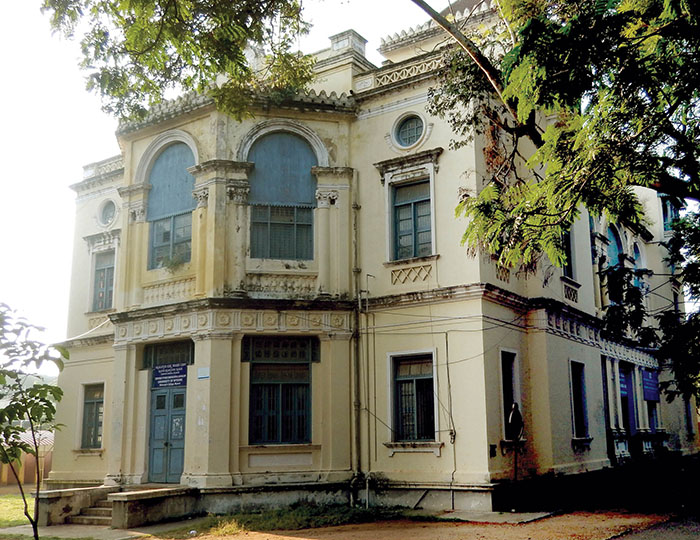
Silvery eloquence compels respectful hearing
Writing under the caption, “The Union of My Time”, C. Narasimha Moorty, who was the Student-Secretary of the Union in 1950s, recalls the association of eminent personalities in the Union debates and says, “One can never forget certain personalities — Principal J.C. Rollo, who enlivened the dullest of the subjects with a style of speech fresh like air in the fields around the Maharaja’s College on a morning after a night of summer rain and with delightful humour; Prof. A.B. Mackintosh whose child-like eyes twinkled with mischief when he countered heavy argument with delicate sarcasm; Prof. A.R. Wadia whose silvery eloquence compelled respectful hearing; Prof. V.L. D’Souza, who could, with or without previous notice, make an appropriate speech for any occasion, and whose jokes, stories and anecdotes made him the most popular “Mr. Speaker”; Prof. C. R. Narasimha Sastry who spoke English with Vedic accent and whose undisguised cynicism thrust points home; N. Kasturi whose genuine wit and refreshing outlook marked him out as an accomplished speaker; and M.A. Venkata Rao whose profound learning and fluency made one wonder whether thought or speech was the quicker of the two with him.”
Such were the speakers and debates that drew students in large numbers. The students showed a keen interest in the debates and members of the staff, “from whom we derived inspiration and intellectual sustenance” also attended them. Equally popular were the dramas staged by the members and the staff.
Moorty also recalls the association of personalities like M.P.L. Sastry, N. Srinivasamurthy, Union President K.B. Madhava, Staff Secretary N. Kasturi, and those who took part in Union dramas like N.S. Narayana Sastry, Ahobalachar, V.K. Srinivasan, A.M. Natesh, A.C. Narasimha Murthy, B. Krishna Moorty, C.B. Jaya Rao and N. Nagesh Rao, “who were endowed with histrionic talent of the highest order.” All these and other personalities made a name in the fields they chose in the later years.
Regular elections were conducted to elect the office-bearers. A Union Magazine was published every fortnight highlighting the Union activities and containing refreshing articles. The Union had a large membership and enough revenue to conduct its activities. With sufficient money and facilities for self-expression in various fields, it was, “a potent agency for the development of personality among University students.”



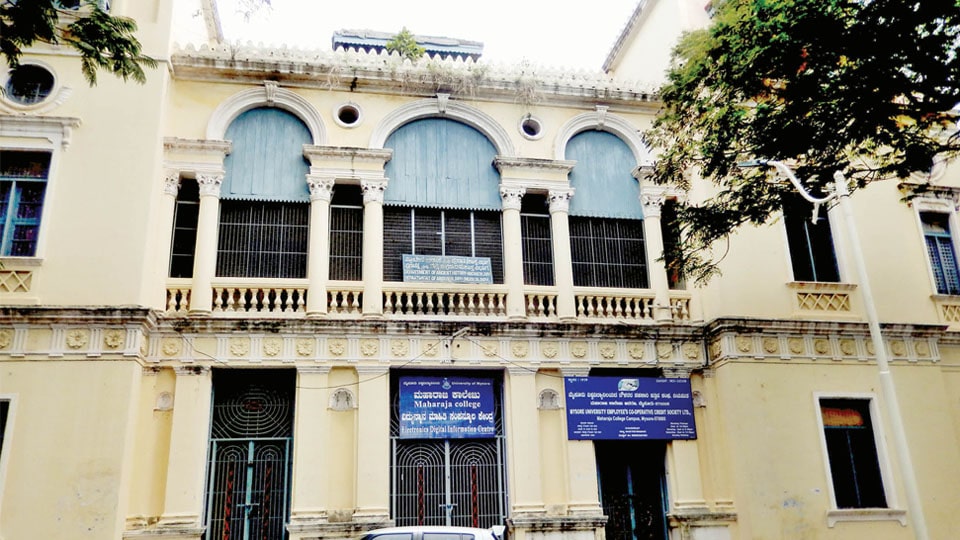

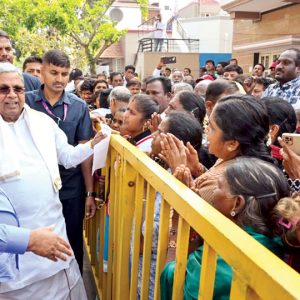
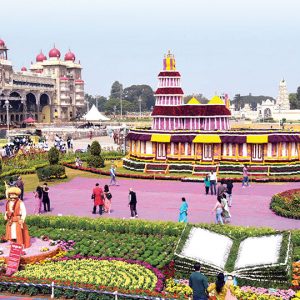
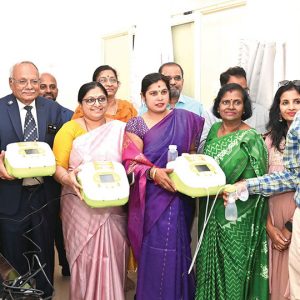
Recent Comments